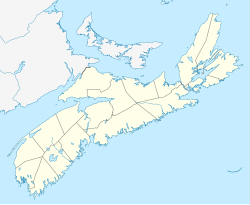Digby (Nova Scotia)
| Digby | ||
|---|---|---|
| Lage in Nova Scotia | ||
| Staat: | ||
| Provinz: | Nova Scotia | |
| County: | Digby County | |
| Koordinaten: | 44° 37′ N, 65° 46′ W | |
| Fläche: | 3,15 km² | |
| Einwohner: | 2060 (Stand: 2016[1]) | |
| Bevölkerungsdichte: | 654 Einw./km² | |
| Zeitzone: | Atlantic Time (UTC−4) | |
| Postleitzahl: | B0V | |
| Gründung: | 1783 | |
Digby ist eine Stadt im Westen Nova Scotias im Annapolis Valley an der Bay of Fundy.
Die ersten Siedler waren nordamerikanische Loyalisten unter der Führung von Sir Robert Digby, die 1783 die gleichnamige Stadt gründeten.
Digby ist Administrationssitz und wirtschaftliches Zentrum des gleichnamigen Regierungsbezirkes. Tourismus und Fischerei (Amerikanischer Hummer, Kammmuscheln) spielen eine bedeutende Rolle im Wirtschaftsleben.
- Digby
Tourismus
Seit dem Bau des Resorts The Pines, das 1929 entstand, wuchs der Tourismus bis in die heutige Zeit. Digbys Hauptattraktionen sind das jährliche Scallop Days Festival und der enorme Tidenhub in der Bay of Fundy, der zu den größten der Welt zählt.
Von Brier Island aus, das von Digby per Auto erreicht werden kann, werden geführte Touren zur Beobachtung von Walen angeboten. Speziell in den Sommermonaten können Buckelwale, Finnwale, Zwergwale und weitere Walarten gesichtet werden.
Digby kann über den Highway 101 oder mit dem Fährschiff von Saint John (New Brunswick) erreicht werden. Die Fähre wird von Bay Ferries Limited betrieben.
Weblinks
Einzelnachweise
- ↑ Statistics Canada: Census Profile, 2016 Census – Digby, Town (Census subdivision), Nova Scotia and Nova Scotia (Province), abgerufen am 15. Juni 2021
Auf dieser Seite verwendete Medien
Autor/Urheber: Dennis Jarvis from Halifax, Canada, Lizenz: CC BY-SA 2.0
The phenomenal Balancing Rock is approximately four feet wide and twenty feet tall. A wonderful quirk of nature, this immense basalt column stands alone after many like it have dropped into the sea and the earth.
Roughly 200 million years ago Nova Scotia was located in the interior of the super-continent, Pangaea. Movements that began during the Triassic Period were so dramatic they eventually resulted in the break up of Pangaea into North and South America, Africa and the Atlantic Ocean. Today, when the earth's crust moves and shifts, we often witness changes of a similar magnitude caused by the devastating and destructive results of immense earthquakes and tsunamis.
Deep beneath the Earth's crust (the lithosphere: a solid array of plates) is a layer of heated rock known as the asthenosphere. It is heated by the radioactive decay of elements such as uranium, thorium and potassium. This heat causes the ocean floors to continually move, shifting and separating from the center in different directions.
The crustal portions of oceanic plates primarily consist of basalt. As the continents shifted, lava forced to the surface cooled and formed into columnar basalt sea stacks. These columns are usually six-sided, but can feature as few as three or as many as twelve (or more) sides.Autor/Urheber: NordNordWest, Lizenz: CC BY-SA 3.0
Positionskarte von Nova Scotia, Kanada
Autor/Urheber: Aconcagua, Lizenz: CC BY-SA 3.0
Hafen von Digby, Neuschottland, Annapolis Basin








